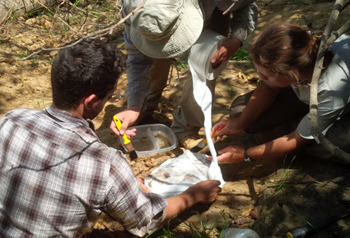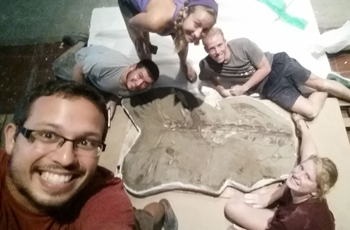By Dawn Mitchell | PCP PIRE and GABI RET Project Assistant

In order to make the most of the short window of opportunity for fossil collection during the expansion of the Panama Canal, PCP PIRE quickly had to forge new and lasting relationships abroad. With assistance from the Smithsonian Tropical Research Institute (STRI) and the Panama Canal Authority (ACP), PCP PIRE researchers were able to set out on several field excursions to collect fossils in and around the Canal. PCP PIRE was also able to show the general public of Panama a few of their fascinating discoveries by assisting in the design of several exhibits in the recently opened BioMuseo. Since the opening of the museum in the fall of 2014, nearly 200,000 visitors have entered its doors to learn about Panama’s present and past biodiversity.
While PCP PIRE researchers assisted with fossil collection over the course of the project, the bulk of PCP PIRE’s recovery efforts is represented by the work of 41 undergraduate, post-baccalaureate, and graduate students, who collected fossils nearly continuously since the start of PCP PIRE’s “Boots on the Ground” field internship program in 2012. When the internship program began, field interns would spend around 3-4 months living in Panama. In the final year of the program the internship was lengthened, and PCP PIRE’s final two field interns lived and worked in Panama for nearly a year.

While learning and constantly practicing paleontological field techniques, the interns gained experience working with foreign institutions and colleagues. After completing a morning of fieldwork, the interns would return to the Center for Tropical Paleoecology and Archaeology (CTPA) to catalog their findings and work on research. Several summer interns were able to participate in a field course that focused on the geology of the Azuero Peninsula with students and faculty from Universidad de los Andes in Colombia. Other groups of interns were heavily involved with the BioMuseo, preparing specimens for exhibits and training docents on the geologic narrative of Panama.
When the field interns were not collecting or cataloging fossils, they had the chance explore Panama City and other nearby areas, picking up some Spanish and becoming familiar with the local culture. On the PCP PIRE blog, the interns detailed their adventures exploring Panama City and witnessing the amazing biodiversity of the modern Neotropics on Barro Colorado Island and other areas full of natural wonders, which were quite fitting alongside their efforts to uncover clues about the biodiversity of Panama’s ancient past.
PCP PIRE’s field interns were certainly the linchpin of our fossil collection efforts, and many have continued to work with PCP PIRE and affiliated projects even after the end of their internship. Several have published and presented their research with other PCP PIRE scientists and others have acted as STEM role models through the GABI RET program, visiting classrooms and inspiring the next generation of scientists. The interns’ work in Panama was integral to the success of PCP PIRE, and we hope that their experience has been similarly essential to their personal and professional growth.
For a list of the field interns, their blog posts and eNewsletter articles, click here to visit the “Field Interns” page on the PCP PIRE website.
Por Dawn Mitchell | Ayudante de los proyectos PCP PIRE y GABI RET

Para aprovechar al máximo el tiempo corto para la colección de fósiles durante la expansión del canal de Panamá, PCP PIRE tuvo que formar rápidamente unas nuevas relaciones. Con la ayuda del Instituto de Investigaciones Tropicales del Smithsonian (STRI) y la Autoridad del canal de Panamá (ACP), los investigadores de PCP PIRE pudieron hacer varias excursiones de campo para recoger fósiles en y cerca del canal. PCP PIRE también mostró unos de sus descubrimientos fascinantes al público panameño por ayudar en formar unas exhibiciones en el BioMuseo recién abierto. Hace el abrir del museo en el otoño de 2014, casi 200,000 visitantes han entrado para aprender sobre la biodiversidad actual y antigua de Panamá.
Aunque los investigadores de PCP PIRE ayudaron con la colección de fósiles, la mayoría de los esfuerzos de recoger es representada por el trabajo de 41 estudiantes y postgraduados quien colectaron fósiles casi continuamente desde el principio del programa de pasantías de campo “Boots on the Ground” de PCP PIRE. En los primeros años del programa, los estudiantes pasaron 3-4 meses en Panamá. En el año final, los últimos dos becarios de PCP PIRE vivieron y trabajaron en Panamá un año.

Mientras aprendiendo y practicando técnicas de campo de paleontología, los becarios ganaron experiencia trabajando con instituciones y colegas extranjeros. Después de una mañana de trabajo de campo, regresaban al Centro para Paleontología y Arqueología Tropical (CTPA) para ordenar y catalogar sus descubrimientos y trabajar en las investigaciones. Varios de los becarios participaron en un curso enseñado en el campo que se enfocó en la geología de la península Azuero con estudiantes y profesores de la Universidad de los Andes en Colombia. Otros grupos de becarios trabajaron con el BioMuseo, preparando especímenes para exhibición y entrenan los docentes sobre la narrativa geológica de Panamá.
Cuando los becarios no estaban colectando o catalogando los fósiles, tuvieron la oportunidad de explorar la Ciudad de Panamá, aprendiendo un poquito de español y familiarizándose con la cultura local. En el blog de PCP PIRE, los becarios detallaron sus aventuras explorando la ciudad y siendo testigos de la biodiversidad maravillosa de los neotrópicos modernas de la isla de Barro Colorado y otros lugares llenos de asombros naturales, que fue buen paralelo a sus esfuerzos de descubrir pistas de la biodiversidad del pasado antiguo de Panamá.
Los becarios de PCP PIRE eran la clave al logro de los esfuerzos de colección, y muchos han continuado trabajando con PCP PIRE y proyectos asociados después del fin de sus pasantías. Varios han publicado y presentado sus investigaciones en conjunción con otros científicos de PCP PIRE, y otros han sido modelos a seguir por el programa GABI RET, visitando las clases e inspirando la próxima generación de científicos. El trabajo de los becarios en Panamá fue integral al logro de PCP PIRE, y esperamos que su experiencia haya sido similarmente esencial a su crecimiento personal y profesional.
Para ver mas información sobre los becarios, haz clic aquí para visitar la pagina web de los becarios.